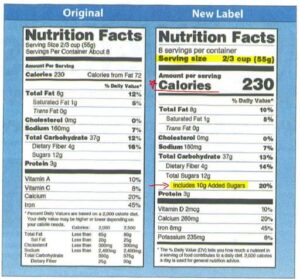I want to talk about changes the food industry has made that will support both of those efforts. As of 2020, nutritional labels on purchased foods have new requirements. There are several changes on these new nutritional labels. Three of which I want to bring to your attention:
- Portion sizes are more realistic and reflect the amount that people actually eat. In the past, food companies would often have artificially small portion sizes which made the food seem like it had less calories than it really did. However, be careful not to let these larger portion sizes be an excuse to eat more!
- The number of calories in a serving is in a much bigger, bolder type. This should make it easier to keep track of calories consumed throughout the day.
- Most importantly, there is a separate line for “added sugar”. So, even if you don’t remember all the names for sugar, you can simply look at the line “Added Sugars’ and see the total amount per serving. Ideally, the number should be zero, which is always the case when you eat “real food.”
Take a look at the sample label we’ve included – there are 10 grams of added sugar!

As you can tell from my repeated focus on sugar, it should be a mindful dietary consideration for everyone. There is ample research on the bad health consequences of added sugars (high blood pressure, heart disease, diabetes… not to mention cavities), so adding this to the nutritional label is a welcome change and one I would recommend you utilize when shopping.
There is another reason to avoid sugar – sugar feeds bad bacteria, which lowers the balance of good and bad bacteria in our gut. If the bad bacteria wins, it lowers our immune system.
By Dr. Michael Bilof

Are You a Candidate for Weight Loss Surgery?
Take our 60 second assessment and find out if you are a candidate for weight loss surgery


